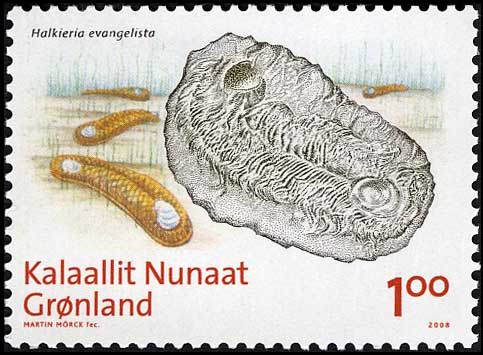
|
БИОЛОГИЯ НА ПОЧТОВЫХ МАРКАХ BIOLOGY ON POSTAGE STAMPS |
|
Vita 00001 → Animalia 00010 → Mollusca 00112 → Diplacophora 00805 |
Classis Diplacophora Vinther and Nielsen, 2005 † - 00805
Species Halkieria evangelista Conway Morris & Peel, 1995 †
Halkieria
is a fossil organism from the Lower to Middle Cambrian.
It has been found on almost every continent in deposits of this age in socalled
small shelly fossil assemblages.
Halkieria is best known from the North Greenland Sirius Passet Lagerstätte in
which complete specimens were collected on an expedition in 1989.
The fossils were described by Simon Conway Morris and John Peel in a short paper
in 1990 in the journal Nature later a more thorough
description was undertaken in 1995 in the journal Philosophical Transactions of
the Royal Society of London and larger evolutionary implications was posed.
Phylogenetic position of Halkieria
When Conway Morris and Peel described Halkieria evangelista from North Greenland
they noticed the similarity to Wiwaxia known especially from the Burgess shale
which has sclerites organised in similar zones. They also noticed the similarity
of the shellplates to inarticulate brachiopods. This led them to suggest that
Halkieria is a stemgroup brachiopod which had evolved into the bivalved
brachiopod by gradually getting inclosed within the two valves and starting a
sessile lifemode. Wiwaxia should be the stemgroup of Annelids or Polychaetes
according to Nicholas Butterfield (1990) which is led by the recognition of its
sclerites having a similar ultrastructure as polychaete chaetae secreted by
numerous microvillae. A number of other scientists has been stressing molluscan
affinites of Halkieria. According to Vinther and Nielsen (2005) there is no
characters supporting either brachiopod or annelid affinity of Halkieria. All
characters seem to be compatible with molluscs, especially the Chitons or
Polyplacophora.
Lately, a redescription of the Burgess shale fossil Odontogriphus has revealed it as being a mollusc relative instead of some sort of lophophorate. The tooth apparatus has many compelling similarities with a molluscan radula along with a foot-like area and surrounding gill-like structures (supposed ctenidia). The tooth apparatus is also very similar to Wiwaxia, which hereby possibly marks some important links between these Cambrian enigmas.
Ссылки - Links
Систематика и описание
http://en.wikipedia.org/wiki/Halkieria
Систематика и описание
http://www.nationmaster.com/encyclopedia/Halkieria
Начато: 30.08.2007 Обновлено: 16.03.2008, 08.05.2008